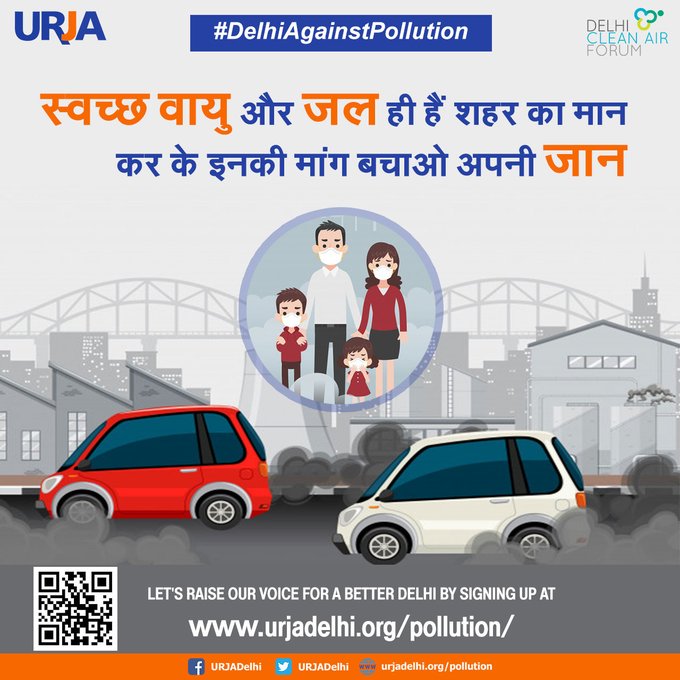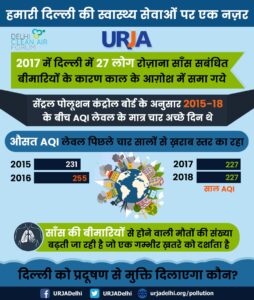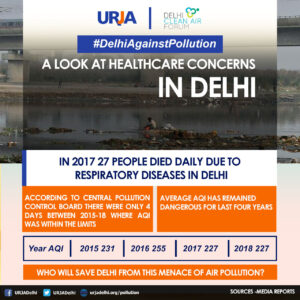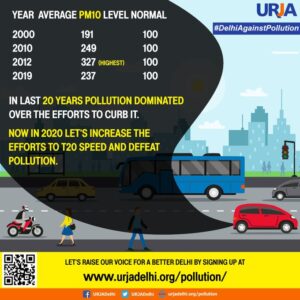Delhi’s rapid urbanization is one of the key drivers of economic prosperity in the National Capital Region. But with unprecedented growth comes formidable environmental-related challenges – including air pollution, which is causing severe public health challenges. Air pollution in India is estimated to kill 1.5 million people every year; it is the fifth-largest killer in India. Currently, India has the world's highest death rate from chronic respiratory diseases and asthma, according to the WHO. As reported in Delhi, poor quality air damages irreversibly the lungs of 2.2 million or 50 percent of all children.
Delhi Clean Air Forum

Let's get serious about Air Pollution and make our voices heard.
Indeed, the Delhi government has announced a number of measures to ostensibly contain air pollution, which include shutting down power plants in Delhi, penalizing leaf and garbage burning, and allowing either odd or even-numbered cars on particular days in the city. The Judiciary too has ordered for the restoration of footpaths and penalizing of air pollution from fossil fuels and construction-related dust. However, statistics of children and adults with weak lung capacities, asthma, cancer, and other respiratory diseases continue to rise thus creating a dire need for more definite action on the ground which needs to extend beyond awareness campaigns alone.
OUR DOCUMENTS
Lorem ipsum dolor sit amet, consectetur adipiscing elit. Vivamus in magna ac tellus fringilla eleifend. Mauris et velit risus. Phasellus nisi ipsum, fermentum eget consequat non, molestie at augue. Proin rutrum sem a rutrum ultricies. Nunc felis neque, dictum ut porta a, ullamcorper vel ante. Quisque non consequat ligula. Pellentesque porttitor eu nisi eu bibendum. In non faucibus justo, et viverra lectus. Fusce sodales mauris et velit accumsan vulputate.
Lorem ipsum dolor sit amet, consectetur adipiscing elit. Vivamus in magna ac tellus fringilla eleifend. Mauris et velit risus. Phasellus nisi ipsum, fermentum eget consequat non, molestie at augue. Proin rutrum sem a rutrum ultricies. Nunc felis neque, dictum ut porta a, ullamcorper vel ante. Quisque non consequat ligula. Pellentesque porttitor eu nisi eu bibendum. In non faucibus justo, et viverra lectus. Fusce sodales mauris et velit accumsan vulputate.
Lorem ipsum dolor sit amet, consectetur adipiscing elit. Vivamus in magna ac tellus fringilla eleifend. Mauris et velit risus. Phasellus nisi ipsum, fermentum eget consequat non, molestie at augue. Proin rutrum sem a rutrum ultricies. Nunc felis neque, dictum ut porta a, ullamcorper vel ante. Quisque non consequat ligula. Pellentesque porttitor eu nisi eu bibendum. In non faucibus justo, et viverra lectus. Fusce sodales mauris et velit accumsan vulputate.



